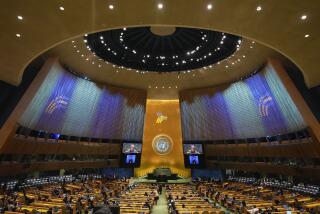Treaty to Stabilize Nuclear Balance, Decrease Incentive for War : Defense: Levels of U.S. and Soviet weapons under the START pact remain virtually the same as nine years ago. But the configurations will change.
- Share via
WASHINGTON — When negotiations for the Strategic Arms Reduction Treaty, or START, began in 1982, the two superpowers stared each other down with arsenals of long-range nuclear weapons that totaled roughly 8,500 Soviet warheads and 9,000 American units.
In those chilly days of nuclear rivalry, Dmitri F. Ustinov, the Soviet defense minister at the time, marked the occasion by charging that Washington was aiming to “attain military superiority over the Soviet Union.”
Ronald Reagan, then President of the United States, charged that a “massive buildup” of Soviet missile forces had made the balance of nuclear terror between the superpowers “steadily . . . less stable.”
Now, more than nine years later, President Bush and Soviet President Mikhail S. Gorbachev are to sign an arms treaty in Moscow that will produce nuclear arsenals virtually identical in size to those that were in place when negotiations began.
But just as the superpowers’ relations and leaders have changed profoundly, the START treaty is expected to transform the composition of their two arsenals and the nature of the nuclear balance.
Indeed, experts say the transition already has begun.
On paper, the START treaty limits each side to 1,600 strategic nuclear delivery vehicles, such as intercontinental ballistic missiles, submarine-launched ballistic missiles and bomber aircraft. It then establishes a separate limit of 6,000 on nuclear warheads that are “accountable” under the complex definitions of the treaty. The result is an accord that technically imposes equal reductions on both sides, but affects each superpower differently.
It also allows the two powers many more nuclear weapons than the treaty language would suggest. The fine print offers “discounts” for some types of warheads that are considered less menacing than others.
RAND Corp. strategic analyst Edward L. Warner III forecasts that, in 1999, at the end of the seven-year treaty implementation period, the United States will have a long-range nuclear arsenal of 9,000 warheads, and the Soviets will have an arsenal of 7,000. Other estimates have set the post-treaty superpower arsenals slightly higher--with a U.S. stockpile at 10,400 warheads and a Soviet stockpile at 8,000.
Those numbers represent reductions of roughly one-third from nuclear force levels that now exist--about 12,000 long-range nuclear warheads in the American inventory and 11,000 in that of the Soviet Union--a disappointing result compared to the initial goal of a 50% reduction.
But in establishing goals for the START talks, the Reagan and Bush administrations also sought to shift the composition of the superpowers’ arsenals in ways that would stabilize the nuclear balance and decrease any incentive for either side to unleash a nuclear war.
For both sides, that has already brought a shift away from heavy reliance on weapons--such as multiple-warhead missiles in fixed silos--that could present a would-be aggressor with an easy and vulnerable target. Traditionally, owners of such missiles, faced with the choice of using them or losing them, have put the weapons on a hair trigger--a fact that further increases the likelihood of nuclear war.
“This is one of those half-empty, half-full issues,” said Warner. In spite of the treaty’s apparently disappointing numbers, he added, the accord’s impact will be enormous because of its effect on the nature of the two forces and the resulting balance of power. “The idea that it doesn’t do anything is just wrong,” he said. “It does provide for a more stable force at lower levels.”
For arms-control proponents, the promised stabilizing effect of the START treaty has largely neutralized disappointment over the superpowers’ inability to negotiate deeper cuts in nuclear weapons and ensured political support during the Senate ratification process.
But although ratification is a virtual certainty, conservatives remain concerned that some of the treaty’s fine print would permit the Soviets legally to gain military advantages over the United States.
In promoting more stable nuclear forces, the START treaty has focused especially on the Soviets’ force of land-based missiles, which accounted for a whopping 80% of Moscow’s long-range arsenal at the outset of the negotiations.
As such missiles have grown increasingly vulnerable to an American first strike, the Soviets--heeding the provisions of the impending START treaty--have begun to place greater reliance on missile-basing schemes that lessen the risk of war.
Turning away from what Warner called a “terrible dependence” on such missiles, the Soviets are expected to reduce the number of warheads on such systems from 6,500 to 2,000.
Overall, Soviet ballistic missile warheads will take cuts of 48% under the treaty’s provisions. For the United States, which traditionally has relied less on such systems to carry its long-range nuclear arsenal, the treaty will result in a cut of about 39%.
Both sides, meanwhile, have moved to increase their reliance on bomber aircraft, responding in part to a significant “discount” that such weapons receive in the treaty’s accounting provisions.
More to Read
Sign up for Essential California
The most important California stories and recommendations in your inbox every morning.
You may occasionally receive promotional content from the Los Angeles Times.











